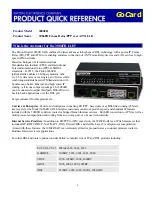
52
Linksys Instant EtherFast
®
Series
51
EtherFast
®
10/100 LAN Cards
11. The workgroup, protocols, cabling and driver are all working properly, but the
PC uses an AMD processor and it can only see itself in network neighborhood.
• In some instances with PCs using AMD processors, the IRQ assigned to
the card by the BIOS (as it gets listed on the bootup screens of most PCs)
doesn't correspond to the IRQ assigned by Windows. This can be fixed by
disabling the IRQ holder for PCI Steering in the Windows Device
Manager. Refer to your PC's documentation for instructions or you can fol-
low the suggested instructions below. Keep in mind that this procedure will
vary depending on your computer’s configuration.
• Click on Start, Settings, Control Panel, then double click the System icon.
Click on the Device Manager tab. Open System Devices, then open PCI
Bus.
• Click on the IRQ Steering tab. Remove the check from Use IRQ Holder
and click OK. Windows will ask you to restart the PC (if it doesn’t ask
you, then reboot the PC manually).
• After the computer boots up, Windows will try to re-detect the PCI
Steering. Continue rebooting the PC until Windows stops detecting new
hardware and settings for PCI Steering. This normally takes a total of
four reboots.
12. While installing the Driver, an error message states that Setup cannot find
OEMSETUP.INF or OEMSETNT.INT.
• Make sure that the installation disk is in your computer’s floppy drive, and
click the OK button.
• Enter the correct path name as shown in the section of this user guide,
detailing installation for the Operating System you are using.
9. You receive DHCP Errors in Windows.
• If you are connecting to a DHCP server, check your cabling and connec-
tion. If you require TCP/IP to be configured, check with your network
administrator or your Windows documentation for proper settings.
• If you don’t have a DHCP server on your network and your network setup
doesn’t require TCP/IP, you may remove the TCP/IP component from
Windows’ networking. To do this, click on Start, Settings, Control Panel,
then double-click on Network. Click once on the component entry with
the words TCP/IP and Linksys or TCP/IP on its own, then click on the
Remove button. Click OK when finished and restart your PC. If the prob-
lem persists, try running the diagnostics.
10. In Network Neighborhood you can only see computers running the same oper-
ating system as your computer (i.e., your PC is running Windows 95 and it can
only see other Windows 95 computers and not any computer running Windows
98).
• Choose Start, Find, Computer and type the name of the computer in the
window that comes up and click Find Now.
• Now make sure that you are using the same protocol(s) and workgroup
name on the 95 and 98 computers. To do this, click Start, Settings,
Control Panel on two computers running different Windows operating
systems. Click on the Network icon, choose the Configuration tab, then
click on the Identification tab for Workgroup name. Compare the proto-
cols on both computers and make sure that they are the same. If any pro-
tocols are missing, refer to the Manually Installing Network
Components in Windows 95 and 98 section in the Appendix to install any
needed protocol(s).
• If all computers are using the same protocol(s) and Workgroup name, and
Windows 95 computers can't see Windows 98 computers, enable NetBIOS
on all the computers using Windows 95 and 98. Follow these instructions:
• The IPX/SPX-compatible protocol should be installed on all Windows
computers (see the Manually Installing Network Components in
Windows 95 and 98 section in the Appendix if you need to add this pro-
tocol). Bring up the properties of the IPX/SPX-compatible protocol by
clicking on Start, Settings, Control Panel, then double-click the Network
icon. Choose the Configuration tab and highlight IPX/SPX-compatible
Protocol. Click on Properties. Now, to install NetBIOS, click on the
NetBIOS tab. Put a check next to I want to enable NetBIOS over IPX/SPX.
Click OK, then OK again. Windows will copy the appropriate files to your
computer. When asked to restart your PC, remove any floppy disks and
click OK. Be sure to do this on all of your computers that are having trou-
ble seeing your entire network.














































